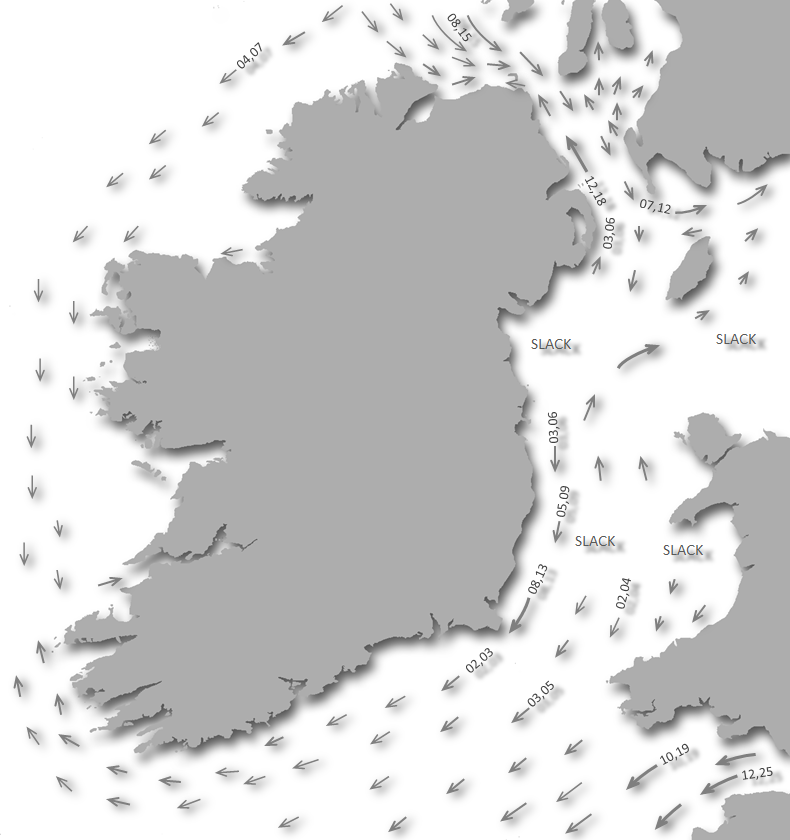.jpg)
The anchorage affords tolerable shelter and is best suited in settled conditions, with protection only from southwest to northwest, and is entirely open from the north through east to south. Due to outlying rocks on either side of the bay, it requires attentive navigation during daylight, and although tidal streams are occasionally strong outside, White Bay is accessible at all states of the tide.

Keyfacts for White Bay
Facilities


Nature






Considerations

Protected sectors
Approaches


Shelter


Last modified
July 19th 2018 Summary
A tolerable location with attentive navigation required for access.Facilities


Nature






Considerations

Position and approaches
Expand to new tab or fullscreen
Haven position
 55° 13.650' N, 006° 55.558' W
55° 13.650' N, 006° 55.558' WThis is the middle of White Bay in approximately 2 metres of water.
What are the initial fixes?
The following waypoints will set up a final approach:(i) Lough Foyle South Channel Initial Fix
 55° 11.760' N, 006° 57.084' W
55° 11.760' N, 006° 57.084' WMidway between the shore and the southern edge of the Tuns Bank in the narrowest part of the South Channel in approximately 10 metres of water.
(ii) Lough Foyle North Channel Initial Fix
 55° 14.155' N, 006° 53.700' W
55° 14.155' N, 006° 53.700' WOne mile east of Inishowen Head and 400 metres northwest of Red Tuns Light (port hand) Buoy F1. R.3s. It is set on the 222° line of bearing of the Martello tower on Magilligan Point that leads into the North Channel.

What are the key points of the approach?
Offshore details are available in the northeast Ireland’s Coastal Overview for Malin Head to Strangford Lough  .
.
 .
.- Lough Foyle’s approaches, the run up the lough to the River Foyle and beyond are detailed in the Foyle Port Marina (Derry City)
entry.
- The anchorage will be found halfway to Dunagree Point with its lighthouses, and south of the rocky Cooladiven outcrops.
Not what you need?
Click the 'Next' and 'Previous' buttons to progress through neighbouring havens in a coastal 'clockwise' or 'anti-clockwise' sequence. Below are the ten nearest havens to White Bay for your convenience.
Ten nearest havens by straight line charted distance and bearing:
- Portnocker - 0.2 nautical miles N
- Portkill - 0.8 nautical miles N
- Cornashamma Bay - 1.2 nautical miles SW
- Silver Strand - 1.7 nautical miles SW
- Greencastle - 2.6 nautical miles SW
- Magilligan Point - 2.7 nautical miles SSW
- Kinnagoe Bay - 3.4 nautical miles NW
- Moville - 4.7 nautical miles WSW
- Carrickarory Pier - 5.3 nautical miles WSW
- Tremone Bay - 5.6 nautical miles WNW
These havens are ordered by straight line charted distance and bearing, and can be reordered by compass direction or coastal sequence:
- Portnocker - 0.2 miles N
- Portkill - 0.8 miles N
- Cornashamma Bay - 1.2 miles SW
- Silver Strand - 1.7 miles SW
- Greencastle - 2.6 miles SW
- Magilligan Point - 2.7 miles SSW
- Kinnagoe Bay - 3.4 miles NW
- Moville - 4.7 miles WSW
- Carrickarory Pier - 5.3 miles WSW
- Tremone Bay - 5.6 miles WNW
Chart
How to get in?

White Strand is a small and beautiful beach at the foot of Inishowen lighthouse situated half a mile to the south of Inishowen Head.
 Set just off the entrance channel to Lough Foyle, approaches to the area are detailed in the Foyle Port Marina (Derry City)
Set just off the entrance channel to Lough Foyle, approaches to the area are detailed in the Foyle Port Marina (Derry City)  entry.
entry.
Come into the middle of White Bay keeping the 2.7 metres high Cooladiven Islets to starboard on the north side of the bay and the headland to port.
 Once inside, anchor according to draft in sand that provides good holding. Land by tender if possible. The bay is open and surf on the beach is commonplace making landing challenging.
Once inside, anchor according to draft in sand that provides good holding. Land by tender if possible. The bay is open and surf on the beach is commonplace making landing challenging.Why visit here?
The surrounding area, and particularly that of White Bay and Portnocker, is known as the town’s land of Stroove. The name is derived from the Gaelic for ‘the beak/point' ‘An tSrúibh’ pronounced ‘trooive'. An tSrúibh is a shortened form of Srúibh Bhrain, pronounced ‘sroo vran’, meaning the 'raven's beak' that is the Irish name for the Inishowen Head. Some local people call it Shrove and others call it Stroove and hence the Inishowen lighthouse may be called several different names all derived from Gaelic.
It is the lighthouse that is by far the most dominant feature of this beautiful anchorage. The coast alongside this part of Inishowen is very rocky and rugged resulting in the establishment of two lighthouses been constructed on Dunagree Point on the 1st of December, 1837. Their purpose was to guide vessels into Lough Foyle and to lead them clear of the Tuns Bank. The lighthouses were designed by the legendary marine engineer Georg Halpin and constructed under his supervision. The twin towers bearing east and west were of cut stone, 140 metres (153 yards) apart. The overall height of each tower was 15 metres (49 feet) and they were painted white. The fixed white lights were 20.4 metres (67 feet) above high water and were established on 1st December 1837. In 1870 the west tower had 8 metres added to its height raising it to a height of 33 metres and a year later a red sector light was added through a glazed opening in the cast iron tower extension just above the granite blocking of the original tower. All the lamps were oil based until 1961 when they were replaced by electric lights, and the East Tower was discontinued at this time. The station was automated on 31st August 1979 when the Keepers were withdrawn and replaced by an Attendant. The Attendant lives in the house nearest to the lighthouse, and the other two dwellings have been converted into staff holiday houses.
Beneath the lighthouse is one of the region's prettiest beaches, Shroove Beach. The sand shelves gently, making it perfect for children, and the picture perfect little bay has rock formations, grassy downs and fine sand dunes to keep young ones exploring. Offshore views include the resort towns of Portstewart and Portrush on the north coast of Northern Ireland. For hikers, the most attractive feature will be the scenic walks that the area offers. These run about 10 km between the small thumb of Inishowen Head through Greencastle and Moville. Here the cliff and strands of the coast are exceptionally beautiful and the secluded cove of Port-a-Doris is particularly noteworthy. It is very understandable why a good population of sailors and fishermen lived here many centuries before Greencastle or Moville were inhabited, and it is just as attractive for visiting boaters today.

From a sailing perspective White Bay, Silver Strand, Cornashamma Bay and Portnocker provide northern access to the eastern Inishowen shoreline. Of the four locations Silver Strand, and Cornashamma Bay immediately south, offer the best protection but White Bay and Portnocker, where Lough Foyle meets the wild Atlantic, are the most northerly berths and as such provide good passage anchorages for boats en route east or west or looking for a lunch stop.
What facilities are available?
White Bay has no facilities and the nearest supplies can be found in the separately covered fishing village of Greencastle or the small town of Moville
or the small town of Moville  . An alternative is the small village of Stroove a few miles north of the village of Greencastle off the R238.
. An alternative is the small village of Stroove a few miles north of the village of Greencastle off the R238.Any security concerns?
Never an issue known to have occurred to a vessel anchored at White Bay.With thanks to:
Bill McCann, Londonderry Harbour Master. Photography with thanks to Patrick Mackie, Kenneth Allen, Clifford Payne, Kay Atherton, and Peter Homer.Aerial overviews of Shrove Lighthouse and the bay.
Aerial overviews of Shrove Lighthouse and the bay.
Add your review or comment:
Please log in to leave a review of this haven.
Please note eOceanic makes no guarantee of the validity of this information, we have not visited this haven and do not have first-hand experience to qualify the data. Although the contributors are vetted by peer review as practised authorities, they are in no way, whatsoever, responsible for the accuracy of their contributions. It is essential that you thoroughly check the accuracy and suitability for your vessel of any waypoints offered in any context plus the precision of your GPS. Any data provided on this page is entirely used at your own risk and you must read our legal page if you view data on this site. Free to use sea charts courtesy of Navionics.












